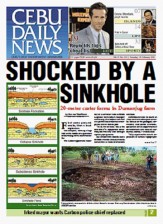20-meter crater forms in Dumanjug farm

Soil collapsed, forming a large hole in the middle of a quiet farm of Dumanjug town, southwest Cebu.
The sudden appearance yesterday of a 20-meter-wide sinkhole surprised town folk in barangay Cambuang who looked with fear at a pit that had swallowed a mango tree and an electric pole.
“In all my 44 years, this is the first time I’ve experienced something like this here,” said barangay captain Jojo Quirante.
But environment officials said a sinkhole was not unusual in Cebu terrain that is made of limestone and karst.
Sinkholes can also be found in Alcoy town and other parts of Cebu because of the geological formation, said Eddie Llamedo, spokesman of the Department of Environment and Natural Resources (DENR) 7 in Cebu City.
Article continues after this advertisement“It’s just part of the natural depression of surface topography caused by karst processes,” he said. He said this is the chemical dissolution of carbonate rocks since limestone is highly soluble.
Article continues after this advertisementBut he said the ground may have also caved in suddenly because of prolonged rains in the past few days and the Feb. 6 earthquake that shook with a 6.9 magnitude.
The DENR Mines and Geo-sciences Bureau will send geologists to the area on Monday.
A cordon was placed around the sinkhole to keep people from going near since the hole is still growing deeper. Two policemen and two barangay tanods started a 24-hour watch there. The nearest house is 100 meters away.
The farm, owned by Swedish national and his Filipina wife who live in Lapu-lapu City, is fenced with barbed wire.
The two-hectare farm in sitio Baclayan has clay soil and is cultivated with tomatoes and eggplants.
In a sinkhole, the ground has no natural external surface drainage. When it rains, all of the water stays inside the hole and typically drains into the subsurface, according to the United States Geological Service website.
“Typically, sinkholes form so slowly that little change is seen in one’s lifetime, but they can form suddenly when a collapse occurs,” it said.
The farm caretaker Walter Pisalbon said he first noticed a large pan-shaped hole in the middle of the farm at 6 a.m. on Friday when he was tending to the eggplants.
He left the farm to eat breakfast. When he returned an hour later, he was surprised to see the soil moving and cracks around the hole. Out of fear, he stayed at the barangay road more than 10 meters away.
At 8 a.m., he said, he heard a loud explosion and sought cover, thinking he was in danger.
After the blast, he noticed the large hole had expanded to about 10 meters in diameter. By noontime, the hole had grown to 12 meters and was still moving, said barangay captain Quirante.
Police who visited the farm said the sinkhole measured 18 to 20 meters in diameter.
How deep the sinkhole reached was hard to say but Quirante said it had swallowed a 14-foot wooden electric pole and a mango tree nearby.
Dumanjug Mayor Nelson Garcia sent the municipal engineer to the site and is asking the Philippine Institute of Vulcanology and Seismology to inspect it. /with a report by Rhea Ruth Rosell